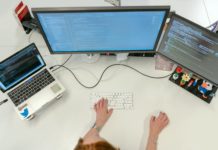In May 2021, JobKred, a Singapore-based AI-powered skills intelligence startup, teamed up with the Singapore National Employers Federation (SNEF) to launch a 90-Day Training Needs Analysis (TNA) programme.
This programme aims to help employers be nimble and embrace new ideas to transform their workplace, traits that are key to rethinking and reshaping the future of work in the current economic climate.
In tackling unemployment which remains high at 4.2% in 1Q 2021, this streamlined TNA programme will support local employers and member companies of SNEF with human capital and business transformation, as well as human resources digitisation efforts.
This will be achieved through job redesign, adopting digital technologies and taking on new ways of work as well as enabling companies to rapidly create and operationalise their competency frameworks to reduce retrenchment rates and extend their business life cycles, even beyond COVID-19.
SMEhorizon speaks with Mr Gary Gan, CEO and Co-founder, JobKred, and Stephen Yee, Deputy Executive Director, Singapore National Employers Federation, on the current challenges brought on by the pandemic, the changing nature of work and technology’s role in facilitating transformation.
We also discuss the progress made through their collaborative TNA programme, and future steps to keep Singapore’s workforce relevant, agile, and employable.
Facing the challenges of the pandemic
What do you see as the main challenge to SME employers in our current economic climate?
[Stephen Yee] The SME employers in Singapore are struggling with manpower shortages in terms of skillsets for their businesses. As with all other businesses in the world, growth is largely affected by COVID-19 disruptions and manpower shortages are accentuated by the fact that as businesses pivot, for example turning to e-commerce, online channels, or process innovation, people will need to adopt the new skillsets that are now required of them.
[Gary Gan] The pandemic has disrupted business operations and accelerated the need for workplace transformation. Many businesses were affected and jobs were displaced due to COVID-19. Companies were unprepared for the uncertainties and HR had to realign their people strategy to adjust to the changing world of work. They had to manage the skills gap, to ensure their employees are equipped with the necessary skills and capabilities to work as some jobs are redesigned and there is an urgent need for skill development.
These changes must have impacted how the HR sector functions as well?
[GG] This disruption caused by COVID-19 has placed HR at the forefront of the organisation, where they are now looked upon to deliver quick results and solutions to top-level business problems. With this added pressure, the progressive HR teams have stepped up to transform their role and job as well, to be more strategic rather than mainly operational and address these massive COVID challenges.
With the workforce disrupted and working from home, HR has also been forced to digitalise and use digital solutions to carry out their work. Every HR professional may need to be a digital-first native going forwards.
Preparing for the changing nature of work
We often hear about the “changing nature of work”. How has this been taking shape on the ground?
[SY] It is changing as we speak. As job roles are disrupted greatly because of acceleration of doing businesses online and process redesign, business is not as usual anymore.
For example, there are now more people working from home versus in the past where most of the people work from office with some telecommuting in place – because of regional work or flexible work arrangements.
How is it likely to develop further?
[SY] Moving forward, in the new normal we will be to be able to work from anywhere and people will be expected to be able to work from home, using technology adoption of IOT and cloud computing technologies.
How can technology help businesses keep abreast of the changes?
[SY] Technology such as cloud computing or technology with Artificial Intelligence built-in, removes routine and mundane jobs of human and this will be useful for businesses as most of them faced the challenge of not being able to get manpower to do such roles.
Processes and controls can be better managed when it is properly designed. This will help to ensure compliance and governance issues as well.
What do new technologies like AI and Big Data mean for HR practices?
[GG] Digital technologies are great enablers of change. If we can break down data silos and identify, develop and apply both internal and external data, HR will be able to utilise the insights to plan and develop their talent strategies especially in the area of skills development and addressing skills gap.
Not to mention that it helps to improve business outcomes and boost productivity. With AI, HR can derive the benefits of accessing insights at the fingertips, remove labour-intensive processes and enable new approaches such as the ability to build their own unique Skills Bank and Skills Intelligence database.
In a previous interview with SMEhorizon, you predicted the rise of aggregators of services and solutions to provide one-stop solutions to HR. Have there been any developments in that area, especially in Singapore?
[GG] I believe that the industry is adapting quickly to this need. For example, for us as a software company, we have to provide various service bundles, beyond just implementation of our software, but also downstream services like searching for and integrating various training providers into our platform on behalf of clients.
Conversely, we have partnerships with many service providers such as HR consultancies who are actively searching for tech solutions to partner with. At the end of the day, the industry now expects a vendor to be able to offer full-suite or one-stop solutions to their problems, and thus services and solutions have accelerated their efforts to work together hand-in-hand to meet client needs.
Skilling the workforce for the future
How has JobKred’s recently launched TNA Programme progressed? How has the response been from Singaporean companies?
[GG] It was launched recently, we are now ramping our outreach to the SME market and seeing good interest. For example, the first webinar we are launching to introduce this program has seen hundreds of signups from interested companies who are eager to find out more. We are excited about this overwhelming demand and look forwards to working with more Singaporean companies to use AI technology to solve their talent management and development issues.
[SY] The upcoming webinar that we are doing are gaining good responses and we hope companies will see the benefits to put in place training as a planned activity, and to see that skills upgrading and reskilling is the only way forward for companies to address the manpower skillsets needed for the new economy.
Are there further steps you would recommend for Singapore to tackle unemployment and deal with the changing nature of work?
[SY] I believe Singapore has historically placed emphasis on the individual, such as with the SkillsFuture Credits, to encourage skills development, and letting the individual take personal initiative to re-skill and re-deploy into the right role.
However, I would recommend Singapore to work more closely with employers to drive further change in transforming the workforce.
Our experience working with employers is that they are very interested and effective in driving change among their workers, to re-train and retain workers and increase their productivity.
However, where they need help is more support in making this practically happen, not just in terms of government grants and subsidies, but in terms of planning, execution and implementation as well.
That’s where enablers like technology to speed up adoption are important to be introduced, especially to SMEs that comprise more than 90% of employers in Singapore.
An even more drastic step could be increased regulation in the areas of skills development, to make continuous professional development a requirement for professions. For example, many professional bodies already practice a system of continual development in the form of regular re-certification or required annual practice or training hours, and placing new skills and technologies as part of this re-certification or practice hours would naturally drive re-skilling and transformation of each job role.
All these practices serve to continue to make sure workers remain relevant and agile and thus stay employable in the market.
What is your advice for SMEs which are seeking to close necessary skills gaps, but may have limited resources and manpower to devote to HR?
[SY] SMEs who have limited resources and manpower can work with SNEF to address their HR needs. We have partners that can help them in this and when they are more ready, they can hire the right staff to continue their HR journey.
There are also government schemes that SNEF offers as we are the programme manager appointed by government agencies to help SMEs. As such, we hope that SMEs can come forward to us, and we will try our very best to assist them.
[GG] To close skills gaps, it is important that SMEs have knowledge or understanding of their employees’ skills and proficiency. Additionally, they need to assess what type of skills need to be acquired for their business. Without the insights, it will be difficult to identify and close their skills gaps.
That’s where tech products can be a game-changer for SMEs, which can reduce the time and cost of transformation by up to 90%. This opens up the opportunity for SMEs with limited time and resources to get quick and effective results in closing skills gaps.














